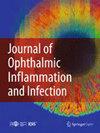Piloting Rasch model scoring of the National Eye Institute Visual Function Questionnaire in uveitis
IF 2.9
Q1 OPHTHALMOLOGY
Journal of Ophthalmic Inflammation and Infection
Pub Date : 2024-04-16
DOI:10.1186/s12348-024-00398-x
引用次数: 0
Abstract
The National Eye Institute Visual Function Questionnaire (NEI VFQ) is a common patient-reported outcome measure (PROM) in uveitis trials. Its psychometric properties using state-of-the-art scoring based on Rasch models, a latent trait model that improves accuracy of PROMs assessment, has not yet been investigated. The study participants were recruited online from uveitis patient organizations, where individuals self-reported their uveitis diagnosis and visual acuity level. These participants then completed the NEI VFQ-25. The visual function (VF) and socioemotional (SE) subscales were psychometrically analysed in terms of item fit, targeting, internal consistency, dimensionality, and differential item functioning (DIF), using Rasch models. Criterion validity was examined based on associations between NEI VFQ person measures and recent visual acuity (VA) levels. Ninety-nine participants recruited online from uveitis patient organizations (68 women, 31 men; mean age 50 ± 15 years; 46.5% self-reported receiving systematic therapy for uveitis, 0.6% NEI VFQ-25 missing data) were included. The mean difficulty of items was lower than the average person ability. None of the items demonstrated misfit to an extent that would induce noise into the measurement. The consistency metrics person reliability and person separation index of the subscales were 0.85 and 2.34 (NEI VFQ-VF), 0.86 and 2.52 (NEI VFQ-SE), respectively. There was no evidence of multidimensionality and none of the items showed DIF by gender. The differences between item and person measures were 1.44 (NEI VFQ-VF) and 1.03 (NEI VFQ-SE). NEI VFQ-25 person measures were significantly lower in participants with visual impairment (all p values ≤ 0.007). Rasch model-based scoring of the re-engineered NEI VFQ-25 demonstrates acceptable internal consistency, item fit and construct validity for assessing two key domains of quality of life in individuals self-reporting uveitis. The PROM was targeted at a higher level of difficulty than present in our heterogeneous sample.美国国家眼科研究所葡萄膜炎患者视觉功能问卷的 Rasch 模型评分试验
美国国家眼科研究所视觉功能问卷(NEI VFQ)是葡萄膜炎试验中常用的患者报告结果测量法(PROM)。它的心理测量学特性是基于Rasch模型(一种可提高PROMs评估准确性的潜在特质模型)的最新评分方法,但尚未进行过研究。该研究的参与者是从葡萄膜炎患者组织中在线招募的,他们在这些组织中自我报告葡萄膜炎诊断和视力水平。这些参与者随后填写了 NEI VFQ-25。采用 Rasch 模型对视觉功能(VF)和社会情感(SE)子量表的项目拟合度、目标性、内部一致性、维度和差异项目功能(DIF)进行了心理分析。根据 NEI VFQ 个人测量与近期视力(VA)水平之间的关联对标准效度进行了检验。从葡萄膜炎患者组织中在线招募了 99 名参与者(68 名女性,31 名男性;平均年龄为 50 ± 15 岁;46.5% 的参与者自称接受过葡萄膜炎系统治疗,0.6% 的 NEI VFQ-25 数据缺失)。项目的平均难度低于个人平均能力。没有任何一个项目的不匹配程度会导致测量结果出现噪音。各分量表的一致性指标人可靠度和人分离指数分别为 0.85 和 2.34(NEI VFQ-VF)、0.86 和 2.52(NEI VFQ-SE)。没有证据表明存在多维性,也没有任何项目因性别而出现 DIF。项目测量与个人测量之间的差异分别为 1.44(NEI VFQ-VF)和 1.03(NEI VFQ-SE)。视力障碍参与者的 NEI VFQ-25 个人测量值明显较低(所有 p 值均小于 0.007)。对重新设计的 NEI VFQ-25 进行基于 Rasch 模型的评分表明,在评估自我报告葡萄膜炎患者生活质量的两个关键领域时,其内部一致性、项目拟合度和结构效度均可接受。PROM 的目标难度高于我们的异质性样本。
本文章由计算机程序翻译,如有差异,请以英文原文为准。
求助全文
约1分钟内获得全文
求助全文
来源期刊

Journal of Ophthalmic Inflammation and Infection
OPHTHALMOLOGY-
CiteScore
3.80
自引率
3.40%
发文量
39
审稿时长
13 weeks
 求助内容:
求助内容: 应助结果提醒方式:
应助结果提醒方式:


